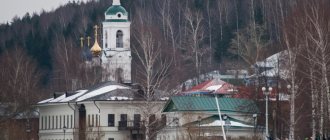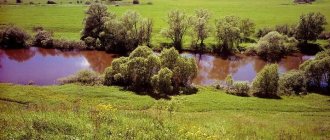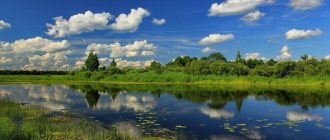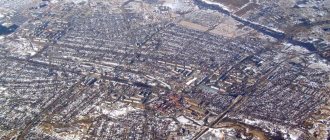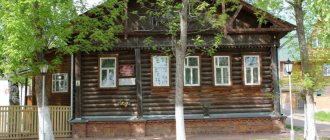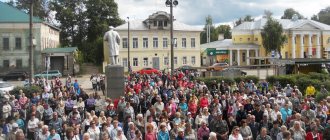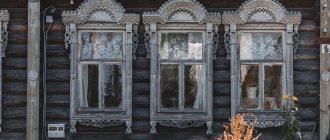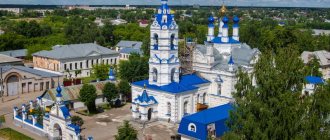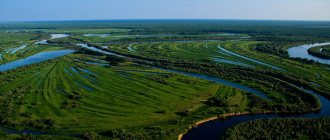The territory of the Ivanovo region has been inhabited since the Stone Age, but the appearance of the first significant settlements that have survived to this day dates back to the 13-15 centuries. Despite such a long history of development, the population of the region cannot be called large: 1,004,192 people on an area of 21,437 km². The density is also low: 46.84. For comparison, in the neighboring Yaroslavl region the figure is 34.82, and in the most populous Moscow region it is 171.44. Economic indicators leave much to be desired: GDP per capita is the lowest among Russian regions: three times reduced compared to the national average.
Churches, cathedrals and temples
Temple of the Icon of the Mother of God Joy of All Who Sorrow (Furmanov)
Address: Furmanov, st. Socialist, 36 Phone: Website: https://krasnaya.cerkov.ru/ Opening hours: 08.00-17.00 Mon-Sun Cost: free
The temple was built by merchant Ivan Ivanovich Skvortsov on the outskirts of Sereda (former name Furmanov) in 1886. In 1894, the daughter of the church founder, who tragically lost her son, decided to expand the small building. The temple turned into a large cathedral by 1904.
The building is designed in the style of ancient Russian architecture. The walls of the temple were painted by the famous artist Safonov together with his students.
Under Stalin, the cathedral was closed. In 1979, a city dweller, Claudia Nikolaevna Lodygina, began to fight for the return of the temple to believers. The persistent woman’s journey through the authorities took almost 10 years. The church reopened in 1988: Claudia Nikolaevna headed the church council.
Bell tower in Lezhnevo
Address: Lezhnevo, st. Oktyabrskaya, 4
The bell tower took 7 years to build; the belfry was completed in 1823. Architect Maricelli began work on the project and was completed by local architect Pavel Voronin. The bell tower, 76 meters high, is depicted on the coat of arms of the Lezhnevsky district.
In the 21st century, the upper tiers of the structure are overgrown with grass, but the clock with chimes, built into the bell tower in 1870, continues to run.
Nikolsky Convent (Privolzhsk)
Address: Privolzhsk, 2nd Ovrazhny lane, 1a Phone: 8 (49339) 3-20-99 Website: https://monpriv.blogspot.com/ Opening hours: 08.00-17.00 Mon-Sun Cost: free
The convent in Privolzhsk was approved in 1998. In the center of the building is the Cathedral of St. Nicholas the Wonderworker, founded in the 14th century. The monastery has organized a shelter and school for girls who have lost their relatives or were removed from dysfunctional families.
Shrines of the Nikolsky Convent:
- icon of the Mother of God “of Many Names”;
- particles of the relics of St. Macarius of Unzhensk;
- Tikhvin Icon of the Mother of God.
Red Church in Vichuga
Address: Vichuga, 2nd Library St., 12 Phone: 8 (49354) 2-57-77 Website: https://sobory.ru/article/?object=01503 Opening hours: 08.00-16.00 Mon-Sun Cost: for free
The brick church in neo-Russian style was founded by the wealthy manufacturer Kokorin in memory of his deceased daughter. There is not a single column inside the building, and the walls are completely painted by the artist Safonov and his apprentices. The façade of the church is decorated with majolica panels, which have no analogues in the world.
The temple was closed in 1930. In 1989, the restoration of the church began, returning to the believers.
Old Resurrection Church in the village of Bonyachki
Address: Vichuga, st. Parkovaya, 5 Phone: 8 (49354) 25-388 Website: https://vichuga-voskr.cerkov.ru/ Opening hours: 08.00-17.00 Cost: free
The stone building in the Russian-Byzantine style was founded by the merchant I. A. Konovalov in 1904. A three-tier bell tower is attached to the church.
The temple was closed in 1936. The interior was looted and destroyed. The Old Resurrection Church was re-consecrated and opened in 1992.
Church of the Exaltation of the Cross in Palekh
Address: Palekh, st. Lenina, 16 Phone: Website: https://xn—-7sbbblo1beyl3e.xn--p1ai/ Opening hours: 08.00-16.00 Cost: free
Master Egor Dubov built the church in 1764, as evidenced by the creator’s autograph on the western side of the building. The spacious temple is painted in a mixed style.
For unknown reasons, the communists did not touch the religious building. The interior decoration has been completely preserved:
- chandelier;
- main iconostasis;
- choirs, candlesticks, lamps;
- embroidered banners;
- side iconostases.
In addition to this church, there is something else to see in Palekh - this is a village famous for its lacquer miniatures and numerous house museums.
Nikolo-Tikhonov Monastery in the village of Timiryazevo
Address: s. Timiryazevo Phone: 8 (49344) 2-21-87 Website: https://tihonov-mon.blogspot.com/ Opening hours: 09.00-17.00 Cost: free
The monastery appeared thanks to the Monk Tikhon, who built a cell in the village. Gradually, a monastery of believers was formed in this place. The Nikolo-Tikhonov monastery was built in 1498.
Under the communists, the monastery was closed. The decoration was completely destroyed, even the bell tower was broken. In 1991, the paint on the building fell off, and the image of Sergius of Radonezh appeared on the wall. Then it was decided to restore the monastery: in 1995 the monastery opened again. The miraculous icon of St. Tikhon has been preserved in the building.
If you have not yet chosen where you will live and want to save money when booking, we recommend using the RoomGuru service. Firstly, it contains hotels, apartments and guest houses from many different booking systems, so you won’t miss out on a worthwhile option. Secondly, you can immediately compare prices for one place in different services and book where it is cheaper (this is not always Booking!).
Urban settlements[ | ]
| № | Name | district[4] | municipal district[5] | population (persons) | founding/first mention | town status | coat of arms | former names |
| 1 | Upper Landeh | Verkhnelandekhovo district | Verkhnelandekhovo municipal district | ↘1618[3] | 1621 | 1985 | ||
| 2 | Ilyinskoye-Khovanskoye | Ilyinsky district | Ilyinsky municipal district | ↘2821[3] | 1619 | 1979 | ||
| 3 | Kamenka | Vichuga district | Vichuga municipal district | ↘3433[3] | 1939 | |||
| 4 | Kolobovo | Shuisky district | Shuisky municipal district | ↘2324[3] | 1941 | |||
| 5 | Lezhnevo | Lezhnevsky district | Lezhnevsky municipal district | ↘7546[3] | 1239 | 1925 | ||
| 6 | Luh | Lukhsky district | Lukhsky municipal district | ↘2580[3] | 1404 | 1959 | ||
| 7 | Nerl | Teykovsky district | Teykovsky municipal district | ↗1789[3] | 1927 | |||
| 8 | Novopistsovo | Vichuga district | Vichuga municipal district | ↘2158[3] | 1938 | |||
| 9 | Palekh | Palekh district | Palekh municipal district | ↘4610[3] | 1618 | 1947 | ||
| 10 | Pestyaki | Pestyakovsky district | Pestyakovsky municipal district | ↘3165[3] | 1379 | 1959 | Pistyaki | |
| 11 | Petrovsky | Gavrilovo-Posadsky district | Gavrilovo-Posad municipal district | ↘2164[3] | 1938 | |||
| 12 | Savino | Savinsky district | Savinsky municipal district | ↘4760[3] | 1869 | 1938 | ||
| 13 | Old Vichuga | Vichuga district | Vichuga municipal district | ↘4615[3] | 1938 |
Settlements that have lost the status of an urban-type settlement[ | ]
- Arkhipovka has been a town since 1948. Transformed into a rural settlement in 2009[7].
- Dolmatovsky has been a town since 1941. Transformed into a rural settlement in 2002[8].
- Dulyapino has been a town since 1938. Transformed into a rural settlement in 2003[9].
- Zavolzhye has been a town since 1934. Incorporated into a city in 1954.
- Zarechny has been a town since 1957. Transformed into a rural settlement in 2004[10].
- Ivankovsky has been a town since 1949. Transformed into a rural settlement in 2002[8].
- Kaminsky has been a town since 1947. Transformed into a rural settlement in 2004[10].
- Komsomolsky has been a town since 1931. Incorporated into a city in 1950.
- Koptevo has been a town since 1949. Converted to a rural settlement in 1961.
- Markovo has been a town since 1940. Transformed into a rural settlement in 2004[10].
- Mosta has been a town since 1946. Transformed into a rural settlement in 2004[10].
- Mugreevsky has been a town since 1942. Transformed into a rural settlement in 2004[10].
- Navoloki has been a town since 1925. Incorporated into a city in 1938.
- Novoe Leushino has been a town since 1939. Converted to a rural settlement in 2004.
- New Gorki has been a town since 1950. Transformed into a rural settlement in 2004[10].
- Ozerny has been a town since 1949. Transformed into a rural settlement in 2002[8].
- Oktyabrsky has been a town since 1941. Transformed into a rural settlement in 2004[10].
- Panfilovo has been a town since 1944. Transformed into a rural settlement in 2004[10].
- Pistsovo has been a town since 1925. Transformed into a rural settlement in 2004[10].
- Podozersky has been a town since 1949. Transformed into a rural settlement in 2004[10].
- Talitsy has been a town since 1991. Transformed into a rural settlement in 2004[10].
- Kholuy has been a town since 1946. Transformed into a rural settlement in 2004[10].
- Yakovlevskoye has been a town since 1925. Transformed into the city of Privolzhsk in 1938.
Cities[ | ]
| № | Name | district/city[4] | municipal district / urban district[5] | population (persons) | founding/first mention | city status | coat of arms | former names |
| 1 | Vichuga | Vichuga | Vichuga, GO | ↘32 971[3] | 1925 | 1925 | ||
| 2 | Gavrilov Posad | Gavrilovo-Posadsky district | Gavrilovo-Posad municipal district | ↘5492[3] | 1434 | 1789 | ||
| 3 | Zavolzhsk | Zavolzhsky district | Zavolzhsky municipal district | ↘9484[3] | 19th century | 1954 | until 1934 - Vladychnoye until 1954 - Volga region | |
| 4 | Ivanovo | Ivanovo | Ivanovo, GO | ↘401 505[3] | 1561 | 1871 | until 1932 - Ivanovo-Voznesensk | |
| 5 | Kineshma | Kineshma | Kineshma, GO | ↘79 936[3] | 1429 | 1504 | ||
| 6 | Komsomolsk | Komsomolsky district | Komsomolsky municipal district | ↘7978[3] | 1931 | 1950 | ||
| 7 | Kokhma | Kokhma | Kokhma, GO | ↗30 336[3] | 1619 | 1925 | ||
| 8 | Navoloki | Kineshma district | Kineshma municipal district | ↘8988[3] | 1775 | 1938 | ||
| 9 | Plyos | Privolzhsky district | Privolzhsky municipal district | ↗1734[3] | 1410 | 1925 | ||
| 10 | Privolzhsk | Privolzhsky district | Privolzhsky municipal district | ↘15 085[3] | 1484 | 1938 | until 1924 - Yakovlevskoye until 1938 - Yakovlevsky | |
| 11 | Puchezh | Puchezhsky district | Puchezhsky municipal district | ↘6010[3] | 1594 | 1793 | ||
| 12 | Springs | Rodnikovsky district | Rodnikovsky municipal district | ↘23 895[3] | 1606 | 1918 | ||
| 13 | Teykovo | Teykovo | Teykovo, GO | ↘31 623[3] | 1613 | 1918 | ||
| 14 | Furmanov | Furmanovsky district | Furmanovsky municipal district | ↘32 855[3] | 1918 | 1918 | until 1918 - Sereda-Upino until 1941 - Sereda | |
| 15 | Shuya | Shuya | Shuya, GO | ↘56 041[3] | 1539 | 1778 | Borisoglebskaya Sloboda | |
| 16 | Yuzha | Yuzhsky district | Yuzhsky municipal district | ↘12 011[3] | 1628 | 1925 | ||
| 17 | Yuryevets | Yurievetsky district | Yuryevetsky municipal district | ↘7837[3] | 1225 | 1778 |
According to OKATO, Kokhma is listed as part of the district, and the city of regional subordination is Furmanov[6].
Settlements that have lost their city status[ | ]
Preserved, but lost city status:
- Lukh is now a town, a city from 1778 to 1925.
Vichuga is a single-industry town with no real prospects
The number of people living in Vichuga is small - 34,868. Moreover, since 1989 there has been a process of steady decline in the number of city residents, which has reduced the figure by 15,000.
However, city status was received only in 1925, as industry began to develop rapidly, the foundations of which had been laid a century earlier by local merchants, factory owners, and simply enterprising people. Today there are several industrial enterprises operating in Vichuga. Tourists are attracted by the remarkable merchant architecture.
Ivanovo is the most densely populated settlement
The capital of the region, Ivanovo, ranks first in the ranking of the largest cities in the Ivanovo region by the number of residents with an indicator of 406,113. The area of the capital is small - 104.84 km², which provides a rather high density, by provincial standards, of 3,873.65. Of course, the Moscow figures are many times higher - 4,925.19. However, for example, compared to neighboring Kostroma, where the figure is 1,918.89, Ivanovo will seem like a fairly densely populated place.
Rapid growth in numbers occurred during the Soviet period:
- 1917 — 174 400;
- 1939 — 285 182;
- 1959 — 336 161;
- 1990 — 480 000.
1991 became special for Ivanovo: the maximum number of residents was recorded - 482,000. However, after the collapse of the USSR, the figures began to fall rapidly: over the next 25 years they decreased by 76,000. However, the city of brides cannot be called a remote province: in the all-Russian ranking of settlements by the number of residents, it ranks 49th out of a possible 1113.
Industry is poorly developed: even the weaving glory of the settlement has sunk into oblivion. Ivanovo is no longer considered the center of the textile industry, since most of the factories could not withstand the new rules of the game of the capitalist world. However, small textile enterprises and sewing cooperatives are still operating. The chemical, food, trade and service industries are developing. Despite this, the standard of living of Ivanovo residents remains at a rather low level, although the capital, by the standards of the region, is the most prosperous settlement. The most ambitious residents of villages and small towns in the region come here for a better life, which is largely supported by demographic indicators.
Kineshma is a quiet provincial town with a declining population
The second place in the list of the largest cities in the Ivanovo region in terms of the number of inhabitants is occupied by the town of Kineshma, located on the right bank of the Volga, where 83,871 people live. One of the oldest cities is mentioned in documents from 1429, but a settlement was founded in its place much earlier. During the reign of Ivan the Terrible, the small settlement had the status of a settlement, then grew to a settlement, and in 1616 it became the center of the Kineshma district. However, despite its regional significance, it received city status only a century and a half later, in 1770.
By the standards of the province, by the standards of the province, before the advent of Soviet power, Kineshma’s industry was considered well developed, involved in the following areas:
- mechanical engineering;
- textile;
- food production;
- electrical engineering;
- chemical industry.
However, the town experienced truly rapid development during the Soviet era. Thus, the Avtoagregat enterprise produced brake systems for Moskvich vehicles, and DSK provided neighboring regions with materials for the construction of housing. With the collapse of the Union, the vast majority of Kineshma enterprises closed, which affected the number and quality of life of the townspeople. Since 1992, the number of inhabitants of the town has been steadily declining: the loss was more than 20,000.
Although Kineshma occupies second place in the ranking, none of the problems of large cities are typical for it. This is a quiet and sleepy place with significant amounts of private residential development. Traffic jams, air pollution, crowds on public transport during rush hour can be found in the capital of the region, but this provincial town is far from such problems.

